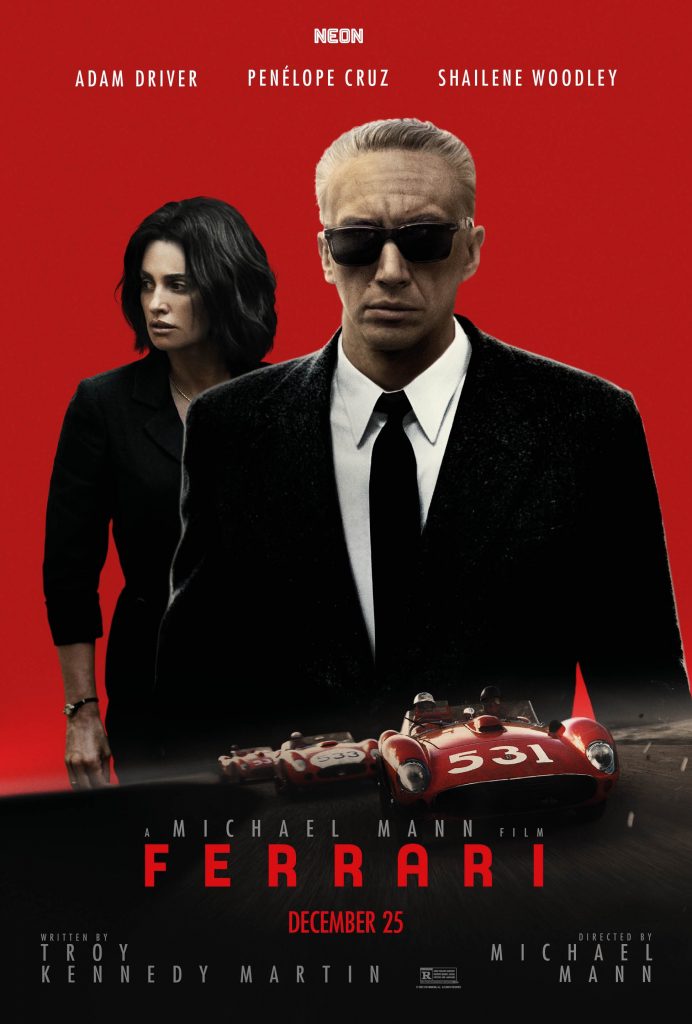Hello Readers,
With Awards Season in full swing, you may be wondering why I chose to go the cinema and see a little mentioned film but my family have always been interested in racing films and Formula 1 in general so it seemed like the perfect watch. The synopsis on the cinema’s website stated essentially it was about the birth of Ferrari as a Formula 1 team as well as a luxury sports car brand.
This definitely lead me and a few others astray. The cinema screening was mainly filled with Formula 1’s main audience – men. Not to say that women are not interested as there were a fair few there – myself included. I think we were all expecting something about the Formula 1 sport and Ferrari’s role within it.
I will get into this in the main body of the review but I think a few people will have walked out of the film disappointed, depending on what they were expecting to see.
Ferrari (2023)

I was surprised on some fronts that the director of this film was not Italian as it had such a vibe of the Italian films of the 70s/80s that I remember watching at university. The long shots with beautiful countryside and quiet village life. Apart from a little black and white montage at the start of the film detailing Enzo Ferrari’s own history of racing, the first half an hour of the film described Enzo’s daily routine rather than his cars.
We see his trip to the barber, visit to the cemetery, driving around the beautiful 50s town of Modena, getting dressed in the morning and his country house with his apparent wife and young son. I thought that Shailene Woodley was an interesting choice for the wife of a well-known Italian but maybe he had met an American woman somewhere.
When we see him in a scene with Penélope Cruz, it becomes apparent that Lina (Woodley) is in fact his mistress and Italian. His wife, Laura handles the accounts for Ferrari and is clearly fed up with Enzo’s treatment of her, even aiming a gun at him and this is before she finds out about his secret son.
Their marriage has become particularly fraught after the death of their son, Dino the year before the film started from muscular dystrophy . It’s clear this took a toll on Laura as she looks haggard and tired, a great acting turn from Cruz who is regularly referred to as a goddess. She is in fact the only person from the film nominated for any major awards – Screen Actors Guild Awards.
The start of the racing begins after a scene that I am sure was influenced by Italian-American film, The Godfather where Ferrari and his fellow factory workers sit in church with their wives while the rival team at Maserati try and break the Ferrari held record for fastest lap round a race track. The cuts between these two tonally different scenes reminded me of the famous christening scene where Michael Corleone is renouncing Satan and it cuts to a murder.
We get to the heart of the action about midway with Ferrari choosing a new driver for the Mille Miglia, a 1000 mile race through Italy after his star driver suffers an unfortunate accident. A few other notable faces pop up as Ferrari drivers including Patrick Dempsey with his bleach blond hair which made headlines at last years awards, and Jack O’Connell of Skins, SAS: Rogue Heroes and Lady Chatterley’s Lover fame.
The newest driver, De Portago campaigns to be Ferrari’s new driver and causes quite a media stir with his Hollywood girlfriend, Linda Christian. As Ferrari knows, any press is good press and gladly welcomes the attention. At home, the drama escalates as Laura reveals that Ferrari is broke and insists on holding onto the control of her shares which Enzo needs to do a deal with Ford to save the company. His mistress, Lina is also pressuring him to publicly accept their son, Piero as a Ferrari ahead of his confirmation.
I thought that Adam Driver did a great job as Enzo Ferrari. He has previously played another notable Italian, Maurizio Gucci in the House of Gucci opposite Lady Gaga and with this portrayal in mind can definitely pull off playing Ferrari. It was maybe a strange period of Ferrari’s life to portray, showing more of his failures than his successes but any good filmmaker prefers to focus on the drama rather than the good parts of the person’s life.
The film sadly ends with what could have been the end of Ferrari, the famous crash during the Mille Miglia killing driver De Portago and nine onlookers. This scene was definitely where the film earned its 15 rating with minimal sex/injury being shown in the earlier scenes. It was obviously done with CGI but just imagining that happening to someone really showed the dangers of the sport even in a seemingly non-contact race through the countryside.
Overall, I really enjoyed this film, despite it not being what was advertised. After the film, I looked up a synopsis on IMDb and if that had been on the cinema website, I suspect the audience may have been smaller and a bit different. There were some great racing scenes but the focus of the film was definitely on Laura and Enzo’s marriage, the grief of losing his son and the potential collapse of the Ferrari brand.
I give this film 4/5.
Happy Watching,
Robyn
